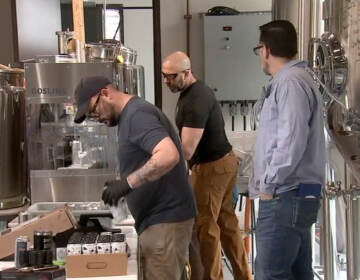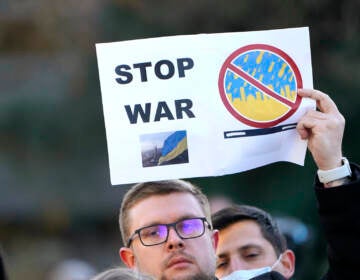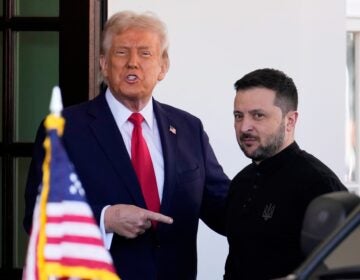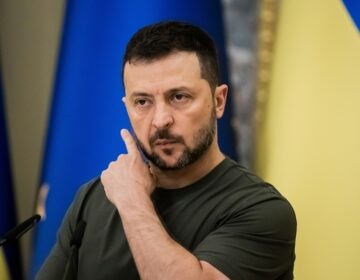Russia steps up bombardment of Kyiv, civilians flee Mariupol
A series of strikes hit a residential neighborhood in a western district of the capital and ignited a huge fire and a frantic rescue effort.
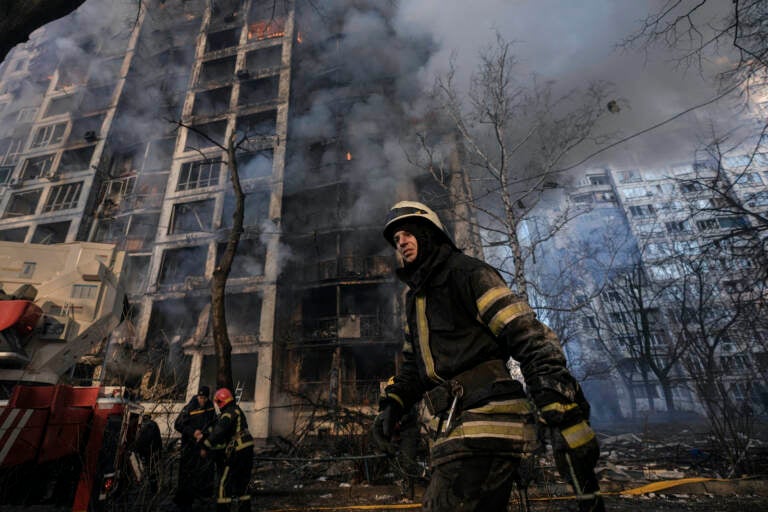
A firefighter walks outside a destroyed apartment building after a bombing in a residential area in Kyiv, Ukraine, Tuesday, March 15, 2022. (AP Photo/Vadim Ghirda)
Russia stepped up its bombardment of Kyiv on Tuesday, smashing apartments and a subway station, while civilians in 2,000 cars fled Mariupol along a humanitarian corridor in what was believed to be the biggest evacuation yet from the desperately besieged seaport.
On the diplomatic front, another round of talks began between Russia and Ukraine via video, and the leaders of three European Union countries — including Poland, a NATO member on Ukraine’s doorstep — planned a visit to the embattled capital in a bold show of support.
With the number of people driven from the country by the war eclipsing 3 million, large explosions thundered across Kyiv before dawn from what Ukrainian authorities said were artillery strikes, as Russia’s assault on the capital appeared to become more systematic and edged closer to the city center.
Ukrainian President Volodymyr Zelenskyy said barrages hit four multi-story buildings in the city and killed dozens of people. The shelling ignited a huge fire in a 15-story apartment building and spurred a frantic rescue effort.
The strikes, carried out on the 20th day of Russia’s invasion, targeted a western district of Kyiv, disrupting a relative calm that returned after an initial advance by Moscow’s forces was stopped in the early days of the war.
The U.N. said close to 700 civilians have been confirmed killed, with the true figure probably much higher.
Fox News video journalist Pierre Zakrzewski was killed when the vehicle he was traveling in was hit by fire Monday on the outskirts of Kyiv, the network said. He was the second journalist killed in Ukraine in two days.
Pierre Zakrzewski was killed when the vehicle he was traveling in was hit by fire Monday on the outskirts of Kyiv, the network said. He was the second journalist killed in Ukraine in two days.
The leaders of Poland, the Czech Republic and Slovenia set out for Kyiv by train despite the security risks, in a visit EU officials said was not sanctioned by other members of the 27-nation bloc.
“The aim of the visit is to express the European Union’s unequivocal support for Ukraine and its freedom and independence,” Czech Prime Minister Petr Fiala said in a tweet. He was joined by fellow Prime Ministers Janez Jansa of Slovenia and Mateusz Morawiecki of Poland, as well as Jaroslaw Kaczynski, Poland’s de facto leader.
The Ukrainian government said new aid and evacuation efforts would take place Tuesday along nine corridors around the country, including the Kyiv region. Many past attempts failed amid continued fighting.
One of the most desperate situations is in Mariupol, the southern city of 430,000 where officials say a weekslong siege has killed more than 2,300 people and left residents struggling for food, water, heat and medicine.
The Mariupol city council reported that 2,000 civilian cars had managed to leave along a humanitarian corridor that runs for more than 260 kilometers (160 miles) west to the city of Zaporizhzhia.
The city council said another 2,000 cars were waiting to leave along the route. It was not immediately clear if the number of departed vehicles given Tuesday included 160 cars that left the day before.
As for the latest round of talks, Ukrainian presidential aide Mykhailo Podolyak said they were discussing a cease-fire and Russian troops’ withdrawal from Ukraine. Russian Foreign Minister Sergey Lavrov said Moscow would press its demands that Ukraine drop its bid to join NATO, adopt a neutral status and “demilitarize.”
Zelenskyy told European leaders gathered in London that his country realizes it can’t join NATO.
“We have heard for many years about the open doors, but we also heard that we can’t enter those doors,” he said. “This is the truth, and we have simply to accept it as it is.”
When Russia launched the war three weeks ago, fear of an imminent invasion gripped the Ukrainian capital, and residents slept in subway stations or crammed onto trains to flee. But as the Russian offensive bogged down, Kyiv saw a relative lull. U.S. officials said Russian forces were about 15 kilometers (9 miles) from the center of the city as of Monday.
Fighting has intensified on Kyiv’s outskirts in recent days, and air raid sirens wailed inside the capital.
Mayor Vitali Klitschko announced a 35-hour curfew extending through Thursday morning.
Tuesday’s artillery strikes hit the Svyatoshynskyi district of western Kyiv, adjacent to the suburb of Irpin, which has seen some of the worst fighting of the war.
Flames shot out of the 15-story apartment building and smoke choked the air as firefighters climbed ladders to rescue people. The assault blackened several floors of the building, ripped a hole in the ground outside and blew out windows in neighboring apartment blocks. Rescue workers said at least one person was killed.
“Yesterday we extinguished one fire, today another. It is very difficult,” a firefighter who gave only his first name, Andriy, said outside the building, tears falling from his eyes. “People are dying, and the worst thing is that children are dying. They haven’t lived their lives and they have already seen this.”
Resident Volodymr Trophimov said he watched as a building was hit. “And then there was a howl, and I watched out of the window, and it crashed into the building and all the windows were smashed,” he said.
Shockwaves from an explosion also damaged the entry to a downtown subway station that has been used as a bomb shelter. City authorities tweeted an image of the blown-out facade and said trains would no longer stop at the station.
A 10-story apartment building in the Podilsky district of Kyiv, north of the government quarter, was damaged. Russian forces also stepped up strikes overnight on Irpin and the northwest Kyiv suburbs of Hostomel and Bucha, said the head of the capital region, Oleksiy Kuleba.
“Many streets have been turned into a mush of steel and concrete. People have been hiding for weeks in basements, and are afraid to go out even for evacuations,” Kuleba said on Ukrainian television.
In the country’s east, Russian forces launched more than 60 strikes overnight on Ukraine’s second-largest city, Kharkiv, according to regional administration chief Oleh Sinehubov. The strikes hit the city’s historical center, including the main marketplace.
Sinehubov said fires were raging and rescuers pulled dozens of bodies of civilian from the ruins of destroyed apartment buildings.
Ukraine’s parliament voted to extend martial law for another month, until April 24. Under the measure, requested by Zelenskyy, men between 18 and 60 are barred from leaving the country so they can be called up to fight.
In Mykolaiv, a strategic southern city near the Black Sea where airstrikes killed nine people Sunday, residents braced for more attacks. Volunteers prepared food and sorted donated clothes at an abandoned naval yard that was turned into a support center for troops. Molotov cocktails were on hand to take on invaders.
“We are bombed during the day and during the night,” said Svetlana Gryshchenko, whose soldier son was killed in the fighting. “It’s a nightmare what Russia is doing on the territory of Ukraine.”
___
Associated Press writers Raf Casert in Brussels and AP journalists from around the world contributed to this report.
WHYY is your source for fact-based, in-depth journalism and information. As a nonprofit organization, we rely on financial support from readers like you. Please give today.


